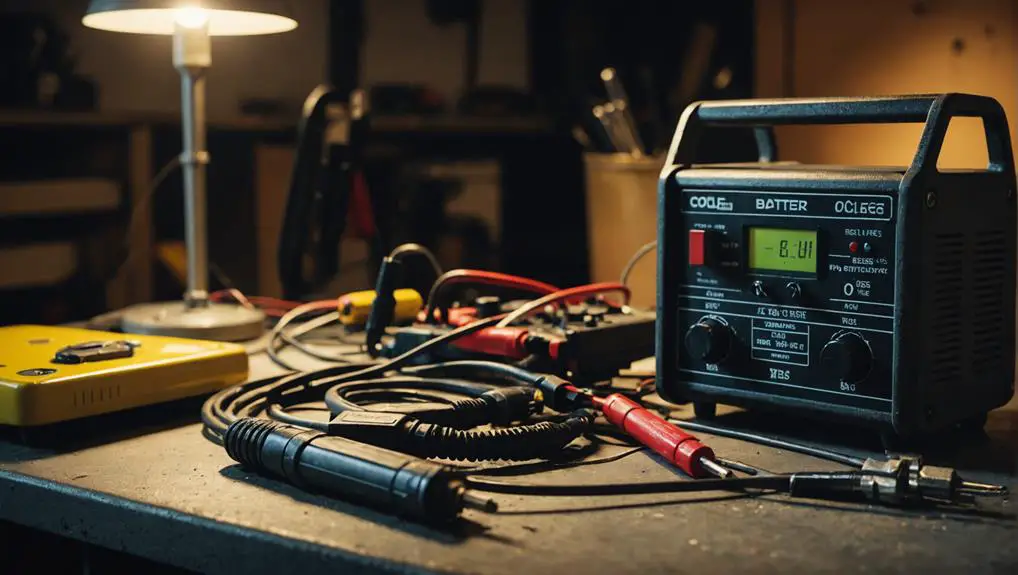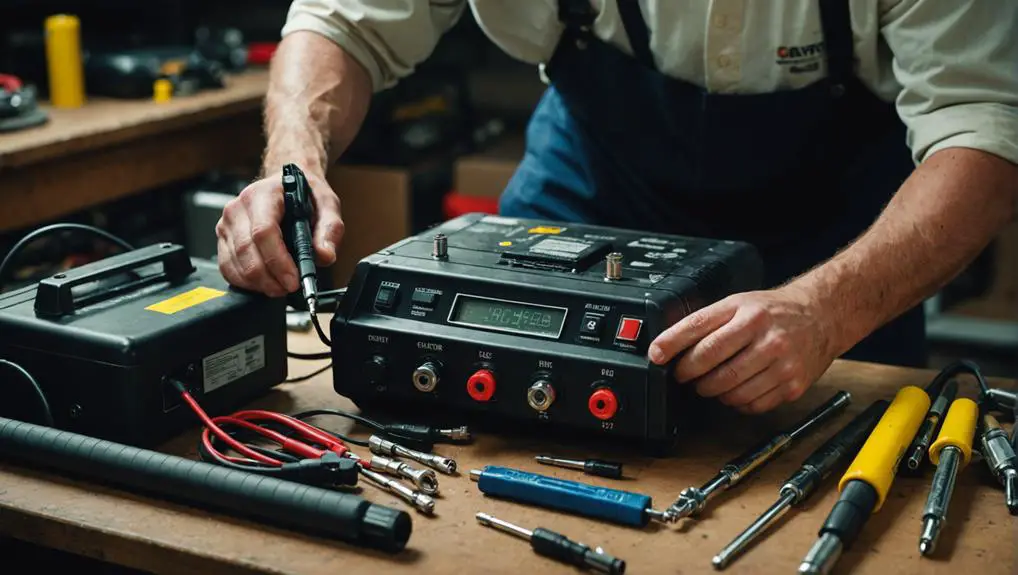When your golf cart battery charger isn't working, it can be frustrating, but don't worry; there are practical steps you can take to troubleshoot the issue. Start by checking the power source and inspecting the charger for any signs of wear or malfunction. You might notice some common issues that could be easily fixed. However, if you find yourself stuck at any point, you may want to contemplate what to do next, especially if you suspect deeper problems. Understanding these nuances could save you time and money in the long run.
Key Takeaways
- Verify the power source by testing the outlet to ensure it is functioning properly.
- Inspect the charger for indicator lights; malfunctioning lights may indicate internal issues.
- Disconnect the charger and check for corrosion or loose connections at the terminals.
- Examine the fuse for continuity; replace it if it is blown to restore functionality.
- If problems persist, seek professional help to avoid further damage or safety hazards.
Common Charger Issues
When dealing with golf cart battery chargers, you might encounter several common issues that can hinder performance. One frequent problem is inadequate charging, often caused by a faulty power source or poor connections. Verify the charger is plugged into a functioning outlet and that the connections are secure. If the charger's indicator light isn't lit, it could indicate a malfunction.
Another issue is an overheated charger, which may result from extended use or poor ventilation. If you notice excessive heat, unplug the charger and allow it to cool before using it again.
You might also experience a charger that won't start at all. This could stem from a blown fuse or a damaged cord. Inspect the charger for visible damage and replace any broken components as necessary.
Lastly, be aware of sulfation, which occurs when lead sulfate crystals build up on the battery plates, impairing charging efficiency. Regularly checking and maintaining your batteries can help prevent this issue.
Safety Precautions to Take
Before you start working on your golf cart battery charger, it's crucial to prioritize safety. Guaranteeing your environment is secure can prevent accidents and injuries.
Follow these precautions to safeguard yourself while you work:
- Disconnect the power source: Always unplug the charger from the wall outlet before attempting any repairs or inspections.
- Wear protective gear: Use safety goggles and gloves to protect yourself from potential acid spills or electrical hazards.
- Work in a well-ventilated area: Ensure adequate airflow to reduce the risk of gas buildup, which can occur with lead-acid batteries.
- Keep a fire extinguisher nearby: Have a suitable fire extinguisher on hand in case of emergencies, especially if you're working with batteries.
Troubleshooting Steps

Troubleshooting a golf cart battery charger requires a systematic approach to identify and resolve issues effectively.
Start by checking the power source; verify the outlet is functioning by plugging in another device. If the outlet is fine, inspect the charger's power cord for any visible damage or fraying.
Next, examine the charger's indicator lights. If you see no lights, the charger might be dead or malfunctioning.
Next, disconnect the charger from the battery and inspect the connections. Look for corrosion or loose connections on both the charger and battery terminals. Clean any corrosion with a wire brush and reconnect securely.
If the charger has a fuse, check it for continuity and replace if necessary.
If your charger has an adjustable voltage setting, confirm it's set correctly for your battery type. For advanced troubleshooting, consult the charger's manual for specific diagnostic codes or error messages.
After performing these checks, reconnect the charger to the battery and monitor the charging process. If it still doesn't work, you might need to explore deeper into the repair or replacement options.
Repairing or Replacing Components
Repairing or replacing components of a golf cart battery charger can often restore its functionality without needing a full replacement. Start by inspecting the charger for obvious signs of damage, such as frayed wires or burnt connectors. If you find any issues, you can usually replace the damaged components individually.
Take into account the following components when diagnosing your charger:
- Fuses: Check for blown fuses and replace them as needed.
- Diodes: Inspect diodes for short circuits or failure; replacing them can resolve charging issues.
- Capacitors: Look for bulging or leaking capacitors; these can often be replaced to restore performance.
- Transformers: If the transformer is malfunctioning, it may need replacement to guarantee proper voltage output.
Once you've identified the faulty components, gather the necessary tools and parts to proceed with repairs.
Always verify the charger is unplugged before starting any work.
After making the repairs, test the charger to confirm it's functioning correctly. If the problems persist despite your efforts, it may be time to contemplate a more thorough solution or replacement.
When to Seek Professional Help

Identifying when to seek professional help can save you time and secure safety when dealing with a malfunctioning golf cart battery charger. If you've followed troubleshooting steps and your charger still isn't working, it's wise to consult an expert.
Signs that indicate you need professional assistance include persistent overheating, unusual sounds, or visible damage to the charger or wiring.
In cases where you suspect internal component failure—such as a burnt transformer or faulty capacitors—don't attempt to fix it yourself. Specialized skills and tools are often necessary for these repairs.
Additionally, if you notice any signs of smoke or burning odors, immediately disconnect the charger and seek professional help. Ignoring these warning signs can lead to hazardous situations.
If your charger is under warranty, contacting the manufacturer is also a prudent choice. They may offer repair or replacement options at no additional cost.
Frequently Asked Questions
Can I Use a Car Charger for My Golf Cart Battery?
You can't use a car charger for your golf cart battery.
Golf cart batteries, typically deep-cycle lead-acid types, require a specific charging voltage and current that car chargers don't provide. Using a car charger may lead to overcharging, damaging your batteries or reducing their lifespan.
Instead, opt for a charger designed for golf carts, ensuring it meets the necessary voltage and amperage requirements for safe and effective charging.
How Long Should a Golf Cart Battery Charger Last?
A golf cart battery charger should last several years if you maintain it well.
Regular checks for wear and tear, proper storage in a dry place, and avoiding overcharging can extend its lifespan.
Typically, you can expect a good charger to function effectively for about 3 to 5 years.
If you notice inconsistent charging or overheating, it might be time to contemplate a replacement to guarantee your golf cart runs smoothly.
What Are Signs of a Failing Battery Charger?
When your battery charger starts failing, you'll notice several signs.
First, if it doesn't power on or shows no indicator lights, that's a clear red flag.
Additionally, unusual noises, such as buzzing or clicking, can indicate internal issues.
You might also see inconsistent charging times or a failure to reach full charge.
Is It Safe to Leave the Charger Plugged in Overnight?
Is it really safe to leave your charger plugged in overnight?
Generally, most modern chargers have built-in safety features that prevent overcharging, so it's usually okay.
However, it's essential to check the manufacturer's guidelines for your specific charger.
If it lacks such features or you're using an older model, it's best to unplug it after a few hours.
Always monitor for excessive heat or unusual sounds to guarantee safety while charging.
Can Extreme Temperatures Affect Charger Performance?
Extreme temperatures can greatly affect charger performance.
When it's too hot, components may overheat, leading to inefficiencies or damage. Conversely, cold temperatures can slow down the charging process and affect battery chemistry negatively.
You should always operate your charger within the manufacturer's recommended temperature range to guarantee peak performance.
If you notice any issues, consider relocating the charger to a more temperature-stable environment for better results.
Conclusion
In summary, fixing a golf cart battery charger often involves straightforward troubleshooting. Did you know that nearly 30% of golf cart battery issues stem from charger malfunctions? By following the outlined steps—checking power sources, inspecting connections, and replacing fuses—you can often resolve the issue yourself. However, if you encounter persistent problems or signs of damage, it's wise to seek professional help to guarantee safety and proper functionality. Your golf cart will be back on the course in no time!